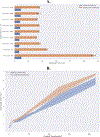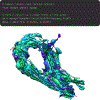An Integrated Toolkit for Extensible and Reproducible Neuroscience
- PMID: 34891768
- PMCID: PMC9044020
- DOI: 10.1109/EMBC46164.2021.9630199
An Integrated Toolkit for Extensible and Reproducible Neuroscience
Abstract
As neuroimagery datasets continue to grow in size, the complexity of data analyses can require a detailed understanding and implementation of systems computer science for storage, access, processing, and sharing. Currently, several general data standards (e.g., Zarr, HDF5, precomputed) and purpose-built ecosystems (e.g., BossDB, CloudVolume, DVID, and Knossos) exist. Each of these systems has advantages and limitations and is most appropriate for different use cases. Using datasets that don't fit into RAM in this heterogeneous environment is challenging, and significant barriers exist to leverage underlying research investments. In this manuscript, we outline our perspective for how to approach this challenge through the use of community provided, standardized interfaces that unify various computational backends and abstract computer science challenges from the scientist. We introduce desirable design patterns and share our reference implementation called intern.
Figures



References
-
- Helmstaedter M, Briggman KL, and Denk W, “High-accuracy neurite reconstruction for high-throughput neuroanatomy,” Nature Neuroscience, vol. 14, no. 8, p. 1081–1088, Jul 2011. - PubMed
-
- Clements J, Dolafi T et al., “neuprint: Analysis tools for em connectomics,” bioRxiv, Jan 2020.
Publication types
MeSH terms
Grants and funding
LinkOut - more resources
Full Text Sources
Research Materials
